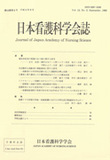Japanese
English
- 販売していません
- Abstract 文献概要
- 参考文献 Reference
- サイト内被引用 Cited by
要旨
本研究は,今日心身医療や看護の実践領域において臨床効果の数多く報告されている行動カウンセリングの一技法であるリラクセーションの訓練課程を検討するものである.実験は,筋反応の緊張・弛緩訓練に,モデリングが有効であることを実証しようとした.被験者49名(男性9,女性40)は,リラクセーション技法として原野の自己弛緩法1)の「片腕斜め上げ,肘弛緩」の教示を受けた.モデリングによる訓練効果は,外顕行動・EMGの身体反応,内省報告の心理反応,および被験者の特性から検討した.
主な結果は,以下のとおりであった.
(1)被検者は,モデリングにより肘弛緩の外顕行動を習得するが,EMG所見上の筋緊張・弛緩の習得と必ずしも一致しないこと,筋反応は緊張より弛緩の習得が困難であること,筋反応の緊張・弛緩習得に部位差のあることなどが明らかになった.
(2)訓練の効果は,「身体内感覚への気づき」を必要と受けとめている者に高かった.
(3)訓練の効果は,不安や「こだわり」の高い者に低かった.
Abstract
The purposes of this study is to evluate the effect of modeling in relaxation training. Nine male and forty female subjects were trained with the technique of relaxation of slanting up one arm, while relaxing the elblow of JICO SHIKAN-HO by K. Harano1). The effect of modeling was found in the appearance behavior and EMG of physiological responces, reflection of subjective responces, and subjects' special quality.
The main results were as follows:
(1) Modeling was effective for learning the appearance behavior. However learning to keep muscles tense and loose could not found by EMG. Adding learning to keep muscles tense were more easier than keeping muscles loose. There existed significant defferent parts in learning to keep muscles tense and loose.
(2) The effects in training was found to be significantly high by awareness of sense in body.
(3) The effects in training was found to be significantly lower by anxiety and persistency.
Copyright © 1992, Japan Academy of Nursing Science. All rights reserved.


